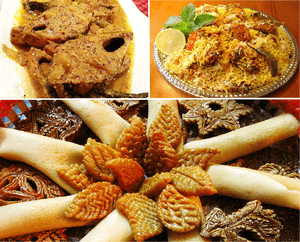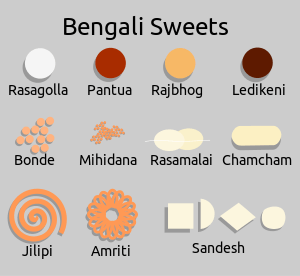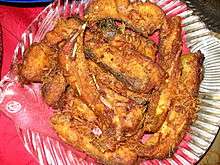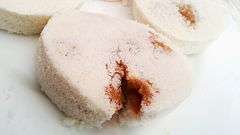Bangladeshi cuisine
Bangladeshi cuisine (Bengali: বাংলাদেশের রান্না) is the national cuisine of Bangladesh. Bangladeshi cuisine has been shaped by the diverse history and river-line geography of Bangladesh. The country has a tropical monsoon climate.
Background
Rice and fish are the main staple food of Bangladeshi people. The famous proverb "mache bhate bangali" translates as "Bengali by fish and rice." Besides fish, an everyday meal consists of plain rice, served with a wide range of curries, leafy greens, lentils, and mashed, braised and/or deep-fried vegetables as side dishes. Bangladeshi dishes exhibit strong aromatic flavours and often include eggs, potatoes, tomatoes and aubergines. A variety of spices and herbs, along with mustard oil and ghee, is used in Bangladeshi cooking. A flat, stone mortar and pestle called "shil pata" are used to grind spices into a paste. Although there are regional cuisines across the many districts of the country, use and consumption of the following items are common throughout the entire country and characterize Bangladeshi food: rice cakes or pitha (there are hundreds of varieties), mustard oil, fish, fish head, mustard paste, ginger, fresh & dry chilies, small fish (e.g. anchovies, mola, tengra), shrimp, lobster, sun-dried fish, fish eggs, the leaves, stalks and roots of taro (colocasia), mashed preparations (bhorta) of vegetables and dried fish, red spinach, leafy greens including the leaves and stems of most vegetables such as pumpkin, bottle gourd (opo squash), radish etc. (water lily and lotus stems are eaten as well), banana blossoms, plantains, milk-based sweets, pickles, chutneys, tamarind, coconut, panta bhat (cooked rice soaked overnight), and the use of banana leaves for both cooking and serving food. People in Bangladesh prefer and use short grain rice. Kalijira and chinigura are the most commonly used aromatic, short grain varieties for items such as polao, murighonto (curry made with fish head and rice), biryani, firni, payesh and pitha. Sticky rice (binni chal) is also popular and a favorite in the Sylhet region. The main breads are luchi, porota, ruti, bakarkhani, rice flour ruti and naan. Dal is another important staple food which is served with rice/porota/luchi. Fish is a staple in Bangladeshi cuisine, especially freshwater fish, which is a distinctive feature of the country's gastronomy. Major fish dishes include ilish (hilsa), pabda (butterfish), rui (rohu), pangash (pangas catfish), pomfret, chitol (clown knifefish), magur (walking catfish), bhetki (barramundi), katla, shing, koral, puti, bowal, koi and tilapia, with paddar ilish (hilsa from the Padma River) being the favorite and the national fish. Fish heads are always special, and serving the fish head is a gesture of special treatment and warm hospitality. Meat consumption includes beef, goat, lamb, venison, chicken, duck, squab, koel and occasionally, wild birds. Dried meat and consumption of organs and the entire animal are common, just like in any part of SouthEast or Northeast Asia. Vegetable dishes, either mashed with mustard oil, dried and fresh chilies (bhorta), boiled (shobji), sautéed, fried or leaf-based (shak), are widely served. A huge variety of plants are consumed as vegetables, and the stems and leaves of entire plants are eaten in Bengali cuisine. Seafood such as lobster and shrimp are also prevalent.
Gourmet pulao is served during feasts and festivals. Different types of Dhakaiya (from old Dhaka) biryani and pulao include kachi, tehari (beef or goat), ilish and murg. Different types of kababs include shikh, reshmi, chapli, shashlik, tikka and shami. Dairy has always been an integral part of Bengali food. The country is home to a huge range of Bengali desserts and confectioneries, ranging from pan-fried or steamed rice cakes (pitha) to halwa, yogurt and sweets made from chhana. Pitha is probably the most traditional food item in Bangladesh, and hundreds of variations are prepared in different districts and especially in rural areas, often with the addition of palm sugar and coconut. Some pithas are prepared with milk as well. Tea is widely consumed as the national beverage and offered to guests as a gesture of welcome. Puffed rice (muri), flattened rice (chira) and popped rice (khoi) are casual snack items kept in all households. Popular snacks include shingara, kochuri, piyaji, dalpuri, pakora, jhalmuri (puffed rice mixed with various spices), pitha (rice cakes), and Bread roll. The phuchka and "chotpoti" are major street foods. The Chittagong Hill Tracts in southeastern Bangladesh feature bamboo shoot cuisine, and the Chittagong district is known for dried fish, crab, stingray and saltwater fish as well as amazing red meat dishes like mezbani and kalabhuna. Bangladesh is also the world's fifth-largest producer of tropical fruits. Jackfruit is the national food of Bangladesh.
While strong Mughlai, Persian, Arabic and Turkish influence on food is seen in Dhaka, especially in Old Dhaka, the food in the rest of the country is more traditional and varies as you travel across the districts. A daily and traditional Bangladeshi meal is similar to food from Southeast Asia, Myanmar, Nepal and the Northeastern states of India. For the rest of India, the similarly with Bangladeshi food lies with dishes that came from either the Middle East or Central Asia and were popularized by the Mughals, e.g. halwa, naan, ruti, kabab, pulao, biryani (though the Dhakai versions are quite different), kofta, korma, which are not eaten daily, but only on special occasions.
A tradition for celebrating the Bengali new year is to begin the day by eating either panta bhat (soaked, cooked rice), broken rice or rice congee along with fried fish, an array of bhortas (mashed preparations) and rice cakes. Different types of rice cakes for new year's day is a must. Bengali sweets, luchi and payesh (rice pudding) are also eaten on this day.
History
Ancient Bengali diets included rice, fish, honey, dairy and vegetables. The region was an administrative and commercial bastion in South Asia during early Hindu and Buddhist kingdoms and later Muslim sultanates. Mughlai cuisine developed in Bengal after the establishment of the province of Mughal Bengal in 1576, as part of the Mughal Empire. The city of Dhaka played an important role in influencing Bengali food with Mughal elements. The British Empire ruled the region for nearly two hundred years between the 18th and 20th centuries, during which the Bengal Renaissance shaped the emergence of modern Bengali cuisine. During the British Raj, Calcutta influenced many Bengali dishes. In the southeast, Arakan cuisine from Burma influenced dishes in Chittagong, particularly dried fish.
The Partition of Bengal in 1947 resulted in the separation of West Bengal from the Muslim-majority East, causing many shifts in demographics and culinary styles.
Bangladeshi cuisine incorporates a large number of cosmopolitan influences, a legacy of the region's historic trade links with the Arab world, Persia, Portugal, the United Kingdom, and Burma. The Portuguese in Dhaka developed cheese. The British introduced tea.
Halal
Islamic dietary laws are prevalent across Bangladesh. Halal foods are food items that Muslims are allowed to eat and drink under Islamic dietary guidelines. The criteria specifies both what foods are allowed, and how the food must be prepared. The foods addressed are mostly types of meat allowed in Islam.
Bangaliketa (Etiquette)
Bangladeshi people follow certain rules and regulations while eating. It includes warm hospitality and particular ways of serving as well. This is known as Bangaliketa (Bengali: বাঙালি কেতা). The culture also defines the way to invite people to weddings and for dinner. Gifts are given on certain occasions. Bangaliketa also includes a way of serving utensils in a proper manner.[1]
Regional cuisines
In Bangladeshi cuisine, some foods are popular across the entire region, while others are specific to a particular area.
.jpg)
Eastern region
The eastern part of Bangladesh has strong influences from Northeast Indian states, such as Assam, Manipur and Tripura. The main characteristic of this food is that it has a lot of use of banana throats, raw papaya fruit, raw mango, urad lentils and grilled or smoked vegetables. The staples of Sylheti people are mainly rice and fish. Their choice and method of cooking is distinctly different to non-Sylhetis. Traditional foods include sour dishes, such as tengha (or tok) cooked with vegetables, including amra, defal, olives (belfoi), dewwaa, amshi, mango choti (aam choti), kul (boroi), hatkhora (or shatkora), ada zamir (ada lembu), and any other sour lemon-like tasty vegetable. Sticky rice is consumed as well. Sylheti people are famous for preparing a wide array of beautiful rice cakes and sweet dishes. Also, many types of meat dishes, including chicken, goat and beef are popular. They have a unique beef curry which is prepared with shatkora.[2]
Chittagong Regions: Ziafat or Mezban feasts are popular throughout the area, where characteristic "heavy" dishes—dishes rich in animal fat and dairy—are featured. Saltwater fish and seafood are quite prevalent in these areas. Shutki (dried fish) is more available in this region than in other parts of the country. Bangladesh's Southern region is also popular worldwide for its fisheries industries with over 100 types of fishes exported every day from this region.
Southeastern region: The Southeastern region of Bangladesh includes the tribal areas that have their own style of cooking methods and ideas. Other than that, the most southern part of this region is mainly influenced by the Arakan cuisine of Burma. Dried fish (shutki), bamboo shoots, sea fish, and many more are the specialties. They use lots of spicy flavours and coconuts in their food preparations.
Central region
The capital Dhaka and its territory region make up the central region, where fresh water fish are more popular. Due to different ruling periods, the cuisine of this region is versatile. The Old Dhaka area is famous for the Nawab Awadhi cuisine. In Old Dhaka, kebabs, naans, bakarkhani, kachchi and pakki biriyani, haleem, mutton bhuni kichuri, Roust and speciality mutton tehari are examples of dishes that became popular in other parts of the country.
Northern region
Rajshahi & Northern Regions: Rajshahi mangoes are considered to be the best in the country. Sweet dishes are also popular. The Northern parts of the country is also renowned for growing pineapple, guava, watermelon, white or sweet melon, green bell apple, wood apple (kotbel), tropic grape, jujube (kul/boroi), pear, litchi, carambola (kamranga), etc. Also famous are the mishti doi of Bogra which are known to be the best in Bangladesh with the desserts of the North being considered amongst the most sweet and delicant in the whole nation.
Southern region
The western areas mainly include the Khulna and Jessore areas and is very close to the West Bengal of India (the region with the second largest concentration of Bengalis in the world). The cuisine of these areas are known as authentic Bengali recipes. Mug dal with hilsha fish head, dalna, chachchari, luchi-payesh, hilsha with mustard are very popular in this region like neighboring West Bengal in India. Coconut milk is very popular in this region. Barisal and Khulna: Piper chaba is a flowering vine in the family Piperaceae. It is called "Chui Jhal" in Bangladesh. Chui Jhal is originally the twig of a Piper chaba. It is a very expensive spice in Bangladesh, has great medicinal value, and tastes somewhat like horseradish. People in Khulna, Bagerhat, and Shatkhira cut down the stem, roots, peel the skin and cut it into small pieces and cook them with meat and fishes, especially with mutton. They love the spicy pungent flavor of spice all year round. A wide range of sweet water fishes are available in this region, which are highly famous all over the country.
Culinary style and influences
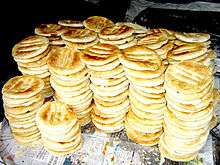
Bangladeshi cuisine has overtime been largely influenced by the Mughlai cuisine left behind by the Persian Rulers. This has led Bangladeshi cuisine to include many rich aromatic dishes such as biriyani and korma that requires the use of a large array of spices along with an extensive amount of ghee. Dhaka being the Mughal Capital of the Bengal Subah (Which Includes the modern Bangladesh and the Indian states of West Bengal) was a major trading center in South Asia so many culinary styles from around the world influenced the city's cuisine. After Dhaka became the capital of East Bengal, Bangladesh the populace began to adopt the cuisine of the city with many unknown Persian, Turkish and Arabic influenced dishes becoming hugely popular.[3]
In Bangladesh the people have adopted a distinct method of cooking and presenting food from their Indian brothers. In Bangladesh meat is a staple with Beef being the most popular meat followed by Chicken and goat meat with Duck being occasionally eaten and Pork eaten only by the Christian and tribal minorities. Meats are usually cooked in a variety of ground and whole spices and tend to be spicy. The most popular method to cook meat is bhuna which is when the meat and onions are fried for a long time with ground and whole spices over high heat. While meats are hugely popular in Bangladesh, fish is the main protein with it being associated with their Bengali identity. Fish is usually cooked in a lightly spiced gravy to allow for the flavor of the fish not to be overpowered. Jhole or ঝোলে is the main method to cook the fish along with vegetables such as potatoes and aubergines. However, shutki is also a popular way to eat fish which is drying, frying and then cooking the fish in a gravy. Shutki is known for its pungent aroma and its spicy and tangy flavor.
Foods and ingredients
- Riverine Areas: Bengal's main staple food of sweet water fish comes from this riverine region. The rivers of Bangladesh are filled with thousands of types of fish. Ilish, Rui, Katol, Koi, Papda, Boal, Citol, Magur, Sing, Mola, Dhlea, etc. are favorites to all. Bangladesh's "Paddar Ilish" (Padma Ilish, Bengali: পদ্মার ইলিশ) is popular in Bengali communities all over the world.
- The staples of Bangladeshi cuisine include rice, which is a common component of most everyday meals[4] and, to a lesser extent, "ruti" (an unleavened whole wheat bread).
- "Atta" (a unique type of whole ground wheat flour) is used for making Luchi, Porota, Pitha, etc.
- Lentils/Pulses (legumes) includes at least five dozen varieties; the most important of which are Bengal gram (chhola), pigeon peas, red gram, black gram (biuli), and green gram (mung bean). Pulses are used almost exclusively in the form of 'dal', except 'chhola', which is often cooked whole for breakfast and is processed into flour (beshon).
- As a tropical country, a wide variety of green vegetables and fruits are available in Bangladesh. A host of gourds, roots and tubers, leafy greens, succulent stalks, citrons and limes, green and purple eggplants, red onions, plantains, broad beans, okra, banana tree stems and flowers, lotus roots, green jackfruit, red pumpkins, and mushrooms are to be found in the vegetable markets or kacha/sabji bazaar.
- Local and hybrid chicken, beef and mutton dishes are favourites across Bangladesh, as well as bird dishes, such as group duck and pigeons.
Medium and spices
Mustard oil and vegetable oil are the primary cooking mediums in Bangladeshi cuisine, although sunflower oil and peanut oil are also used. Depending on the type of food, clarified butter (ghee) is also often used for its aromatic flavours.
Bangladeshi food varies between very sweet and mild to extremely spicy. It resembles food found in other parts of Asia. There are also slight similarities with South East Asian and North East Indian food customs. The most common condiments, herbs and spices in Bangladeshi cuisine are garlic, onion, ginger, turmeric, ghee, sumac, coriander, cumin, dry bay leaves, chili pepper, and chili powder.
The pãch poron is a general purpose spice mixture composed of fennel seeds, fenugreek seeds, nigella seeds, cumin seeds, and black mustard seeds. This mixture is more convenient for vegetarian dishes and fish preparations.
The use of spices for both meat and vegetable dishes is quite extensive and includes many combinations. The combination of whole spices, fried and added at the start or finish of cooking as a flavouring is special to each dish. Whole black mustard seeds and freshly ground mustard paste are also a typical combination. A pungent mustard sauce called kashundi is sauce for snacks or sometimes makes a base ingredient for fish dishes and vegetable dishes popular in Bangladesh.
Common recipe styles

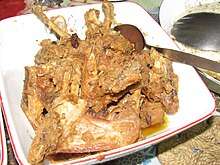
.jpg)
The following is a list of characteristic Bangladeshi recipe styles. Each entry is a class of recipes, producing different dishes depending on the choice of ingredients. There are tastes to which the Bangladeshi palate cater to. These include:
- Achar: Assortment of pickled fruit, vegetables or spices. Generally flavoured with mustard oil, mustard seeds, aniseeds, caraway seeds, and asafoetida or hing.
- Bawra (বড়া): Anything that has been mashed, mixed with thick batter and then formed into a rough roundish shape and deep fried, generally in soybean or mustard oil. Generally it is served with rice as a starter, or served with puffed rice crisps or as a single snack. The bora has quite a few kinds. When potatoes are fried in a light chickpea flour batter, they are called fuluri (giving rise to the Trinidadian pholourie).
- Bhaja (ভাজা): Anything fried (especially potato, aubergine (eggplant), cauliflower, cabbage, fish, chicken) after it has been salted or dipped in any kind of water-based batter. Does not include croquettes or crumb-coated items.
- Bhapa (ভাপা): Fish or vegetables steamed with spices.
- Bhate (ভাতে): A vegetable that has been put in the pot where rice is cooking. It is cooked with the rice. Generally, the vegetable includes potatoes, butternut squash, raw papayas, bitter gourd, snake gourd and okra. It is often eaten with a tinge of mustard oil or ghee and salt. For this, generally "atap chawl" rice is used. It is a short-grained, glutinous rice that cooks quickly and preferred because of its creamy quality and ability to become sticky. That aids the dish when it comes to mashing. At serving, fresh ghee or butter, and salt to taste, is mixed and mashed by hand and then eaten. A raw green chili, and a boiled and shelled egg, sometimes accompany this dish.
- Bhorta (ভরতা): Any vegetable, such as potatoes, aubergine (eggplant), beans, sour mangoes, papaya, pumpkins and shrimp, dried fig or even dal, first boiled whole and then mashed and seasoned with red shallot, fresh chili, mustard oil/ghee and spices.
- Chap (চাপ): Bengali-style croquettes, usually coated with crushed biscuits or breadcrumbs.
- Chutney: Generally, the Bengal region is one of the pioneers for this dish, making it with everything, including preserved mango sheets, called amshotto.
- Dom (দম): Vegetables, especially potatoes, or meat, cooked over a covered pot containing water, slowly over low heat, slightly steaming. The word is derived from the dum technique popular in Mughlai cuisine.
- Ghonto (ঘন্ট): Complementary vegetables (e.g., cabbage, green peas, potatoes, banana blossom, coconut, chickpeas, etc.) are chopped or finely grated and cooked with pouron and ground spices. Dried pellets of dal are often added to the ghonto. Ghee is commonly added at the end. Non-vegetarian ghontos are made, with fish or fish heads added to the vegetables. The famous muri ghonto is made with fish heads cooked in a fine variety of rice. Some ghontos are very dry while others are thick and juicy.
- Kalia (কালিয়া): A very rich preparation of fish or meat using a lot of oil or ghee with a spicy sauce usually based on ground ginger and fresh shallots pasted or fried along with a tempering of gorom moshla.
- Kofta: Ground meat croquettes bound together by spices or eggs, served alone or in savoury gravy.
- Korma: It involves egg, fish or meat cooked in a mild yogurt-based sauce with ghee, and often poppy seed paste is added. People of southern Bangladesh add coconut milk to many of their dishes and korma is no exception.
- Paturi: Generally, oily fish is sliced evenly and wrapped in a banana leaf, after the fish has been basted with freshly pasted mustard with a hint of mustard oil, chili, turmeric and salt.
- Posto: Anything (especially potato, aubergine) cooked with poppy seed paste as the main flavouring agent. Often poppy seed paste with some mustard oil is eaten mixed with rice all by itself as a mild beginner in a meal.
- Shak (শাক): Green leafy vegetables, like spinach and mustard greens, are shredded and cooked until they wilt in a touch of oil and tempering of nigella seeds.
- Torkari: A general term often used in Bengali, the same way 'curry' is used in English. The word first meant uncooked garden vegetables. From this, it was a natural extension to mean cooked vegetables or even fish and vegetables cooked together.
Structure of meals
Each dish is to be eaten separately with a small amount of rice or ruti, so that individual flavours can be enjoyed. The typical Bangladeshi fare includes certain sequences of food. Two sequences are commonly followed, one for ceremonial dinners, such as a wedding, and the other for day-to-day sequence. Both sequences have regional variations, and sometimes there are significant differences in a particular course in Bangladesh.
Ceremonial occasions, such as weddings, use to have elaborate serving rituals, but professional catering and buffet-style dining can be seen now. The traditions have not disappeared; large family occasions and the more lavish ceremonial feasts will still have the same traditional rituals.
In Bengali cuisine, Chutney is mainly served at the end of a meal. It is a sweet & sour thickened curry usually made with local seasonal fruits, such as raw mango, jujube, Bengal quince, etc. with pãch poron (five mix spices) and sugar.
Main course
Bangladeshi foods contain staples, such as rice and flat breads. Different traditional flat breads include Luchi, Porota, Bakhorkhani, Nan, Ruti, Rice Flour Flatbread, Chitai Pitha, and many more. Dishes made from chicken, beef, fish or mutton, as well as dal (a spicy lentil soup) and vegetables commonly accompany rice and flat breads. Traditional dishes can be 'dry', such as gosht bhuna (chicken/beef/mutton). Items with jhol (gravy) are often curried. Bangladeshi cuisine frequently uses fresh vegetables, which generally vary with season. Vegetables are also used for light curries.
On special occasions, such as weddings or other similar ceremonies, Bangladeshi people serve guests with Biryani and Kababs along with other side dishes, which is very popular in the cities and urban areas, and Borhani, which is a spicy drink that is known to aid digestion. Another popular meal is Polao with Rost and other dishes such as Egg korma and Rezala and Kala Bhuna (a beef bhuna). In Bengali culture it is considered rude to only cook a few items so a large array is often made for the guests at least 5/6 dishes.
Desserts
Bengalis take pride on their desserts. Bengalis are the pioneers of making and inventing a variety of sweets in the Indian Subcontinent (pre-partition period). Most of these sweets have been created by a Ghosh (a dessert maker or dairy product seller cast).
The last item before the sweets is doi (baked yogurt).[5] It is generally of two varieties, either natural flavour and taste or Mishti Doi (sweet yogurt), typically sweetened with charred sugar. This brings about a brown colour and a distinct flavour. Bangladeshi cuisine has a rich tradition of sweets. The most common sweets and desserts include:
- Rasgulla – Rasgulla, locally pronounced "Roshogolla" or "Rashgolla", is a sweet made with channa (posset/curdled milk) and sugar syrup. It is one of the most widely consumed sweets. The basic version has many regional variations.
- Khir Toast - Delicate sweet made of ricotta with a thick cream inside
- Vogh sagar - most famous in Dhaka
- Saffron Vogh - made with ricotta, a must for bengali weddings in Dhaka
- Channer Shondesh is a dessert created with milk and sugar.
- Chhanar Mishti – A sweet made from chickpea flour with sugar/jaggery/molasses. Nowadays, there are various types of Chhanar Mishthi available all across Bangladesh.
- Mishti Doi – Sweetened homemade creamy yogurt; prepared by boiling milk until it is slightly thickened, sweetening it with sugar, either guda/gura (brown sugar) or khajuri guda/gura (date molasses), and allowing the milk to ferment overnight.
- Naru – It is usually home-made and used as offerings in Hindu rituals of praying to their deities.
- Rosh-malai – Small rashgollas in a sweetened milk base; Comilla is famous for its Rosh-malai.
- Khaja – Deep fried sweets made from wheat flour and ghee, with sugar and sesame seeds as the coating.
- Mua – Cooked with rice flakes and jaggery.
- Hawai'i Mishti – Made with sugar and given various forms.
- Chhana is fresh, unripened curd cheese made from water buffalo milk.
- Chhaner jilapi – Made in a manner very similar to regular jalebi except they are made with chhana.
- Khir is a common Bangladeshi sweet dish. Phirni, together with Zarda, is also typical during Shab-e-Barat and Eid. It is cooked with dense milk, sugar/jaggery, and scented rice (kalijira rice). Although it takes a lot of time to cook, it is one of the main features of Bangladeshi desserts. A thicker version of khir is used as filling for pitha.
- Gurer Shondesh is a fritter made from rice flour and palm sugar.
- Goja – A light sweet snack made from flour and sugar, and often served as street food, which is consumed both as dessert and starter.
- Chômchôm (চমচম) (originally from Porabari, Tangail District in Bangladesh) – This sweet goes back centuries. The modern version of this oval-shaped sweet is reddish brown in colour and has a denser texture than the rôshogolla. It can also be preserved longer. Granules of maoa or dried milk can also be sprinkled over chômchôm.
- Shemai – It is made with vermicelli prepared with ghee or vegetable oil.
- Balushahi is made from a stiff dough made with all-purpose flour, ghee and a pinch of baking soda. One-inch-diameter (25 mm), 1⁄2-inch-thick (13 mm) discs are shaped with hands, fried in ghee or oil and dunked in thick sugar syrup so that there is a sugar coating. They are very sweet, but tasty with a slightly flaky texture.
- Piţha – In Bangladesh, the tradition of making different kinds of pan-fried, steamed or boiled sweets, lovingly known as "piţhe" or "pitha",[6] still flourishes. These little balls of heaven symbolises the coming of winter, and the arrival of a season where rich food can be included. The richness lies in the creamy silkiness of the milk, which is often mixed with molasses or jaggery made from either date palm or sugarcane, and sometimes sugar. They are mostly divided into different categories based on the way they are created. The most common forms of these cakes include bhapa piţha (steamed), pakan piţha (fried) and puli piţha (dumplings), among others. The other common pithas are chondropuli, gokul, pati shapta, chitai piţha, aski pitha, muger puli and dudh puli. Generally, rice flour goes into making the pitha.
Beverages
- Akher gur Shorbot – Sugarcane juice with jaggery
- Akher Rosh – sugarcane juice
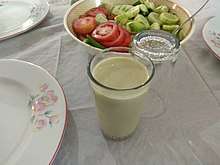
- Borhani – a spicy drink usually served in gatherings, banquets and weddings. It aids digestion.
- Ghol – whisked salted milk
- Jeera pani – a drink boasting fresh, lively flavors and generally served as an appetizer or welcome drink.
- Khejur Rosh – date palm juice
- Laban
- Lassi
- Tea
- Malai
- Matha
- Faluda
- Rooh Afza
- Sharbat
- Mango juice (Ame sharbat)
- Watermelon juice (Tarmuj sharbat)
- Juice of Bengal quince (Bel sharbat)
Specialties by region
| Name | Course | Producing region | Description |
|---|---|---|---|
| Balish Misti | Dessert | Netrokona | Balish Mishti (lit. pillow sweet), called because of its pillow-like shape and huge size, has a history of almost hundred years.[7] |
| Bograr Doi (Yogurt of Bogra) |
Dessert | Bogra | In Bangladesh the most famous variation of Mishti Doi is in Bogra and people of Bogra are known to make the best Mishti Doi[8] |
| Comillar Ras malai | Dessert | Comilla | Ras malai or rossomalai is a dessert originating from the Indian subcontinent. Ras malai consists of sugary white cream, or yellow-coloured (flattened) balls of chhana soaked in malai (clotted cream) flavoured with cardamom. Rasmalai of Comilla created by “Matree Bhandar” is the best and oldest in Bangladesh. It is very popular sweet all over the country.[9][10] |
| Chowk Bazaar Iftar | All courses | Old Dhaka | Chowk Bazaar was one of the most famous business and social meeting centres of Dhaka in the Mughal period. During Ramadan Chowk Bazaar is famous for its Iftar items which include Moghul cuisine and other traditional items. Almost 500 different types of Ifter is prepared for Holy Ramadan.[11][12][13] |
| Chui Jhal Mangsho | Main course | South Bengal | Piper chaba is called চুই ঝাল (Chui Jhal) or চই ঝাল(Choi Jhal) in the South Bengal region of Bangladesh. People in Bangladesh's south-western districts like Khulna, Jessore, Bagerhat, Satkhira & Narail cut down the stem, roots, peel the skin and chop it into small pieces - and cook them with meat and fish, especially with mutton. It is a relatively expensive spice in Bangladesh, and the roots are usually more expensive than the stems because of their stronger aroma. The taste is similar to horseradish. |
| Dhakai Bakarkhani | Entrée | Old Dhaka | Bakarkhani or BaqarKhani, also known as bakar khani roti, is a thick, spiced flat-bread that is part of the Mughlai cuisine of the Indian subcontinent. Dhakai Bakarkhani, the traditional food/snack of the people of old Dhaka is famous for its quality and taste. Bakarkhani is mainly dished up with tea.[14][15] |
| Haji Biriyani | Main course | Old Dhaka | Haji Biriyani (also known as Hajir Biriyani) is the Chevon Biryani dish made with highly seasoned rice and goat's meat. The recipe includes highly seasoned Rice, Chevon, Mustard oil, Garlic, Onion, Black pepper, Saffron, Clove, Cardamom, Cinnamon, Salt, Lemon, doi (yogurt), Peanuts, Cream, Raisin and small amount of Cheese (either Cow or Buffalo). The recipe has been handed over the founder of the restaurant to his next generation.[16] |
| Kala Bhuna | Main course | Chittagong | Beef Kalo/Kala Bhuna is one of the famous beef recipe in Bangladesh. And the specialty of the recipe is its spices. Beef shoulder pieces are cooked with traditional spices till become dark and tender. Kala buna and Mejbani Mangsho preparations are signature dishes of the port city Chittagong.[17][18][19] |
| Mejbani Mangsho | Main course | Chittagong | The Chittagong region is famous for spicy and hot curries – mainly of beef.[17] Mejbani Gosht is very popular and famous. Mezban Persian word literally meaning a host.[20] The word now means 'community feasting', a tradition that originated in Chittagong region. It is usually hosted by rich people. It is hot and spicy and is served with rice.[21][22] |
| Muktagachar monda | Dessert | Muktagachha, Mymensingh | Monda, is a traditional sweetmeat. The sweet, first made in 1824,[23][24] is reputed in Bangladesh and many countries for its originality, taste and flavour.[23] |
| Natorer Kachagolla (Kachagolla of Natore) |
Dessert | Natore | Natore in the Rajshahi Division is famous for Kachagolla. Though it is called golla (means small ball in native Bengali languages) but it has no common shape like other sweetmeat items. It is made of pure chhena or paneer (which is made by curdling the milk and separating the whey from it) and sugar. |
| Porabarir/ Tangailer Chomchom (Chomchom of Tangail) |
Dessert | Porabari, Tangail | Chomchom, cham cham, or chum chum (Bengali: চমচম) is a traditional Bengali sweet originated from Porabari, Tangail, Bangladesh. It is a very popular dessert in Bangladesh and India. The sweet is oval and brownish. |
| Seven Color Tea | Beverage | Moulvibazar | Seven-colour tea or seven-layer tea is a well-known hot beverage in Bangladesh.[25][26] Romesh RamGour invented the seven-layer tea after discovering that different tea leaves have different densities. [27][26] Each layer contrasts in colour and distinct taste, from syrupy sweet to spicy cloves. The result is an alternating dark/light band pattern throughout the drink giving the tea its name. |
| Shatkora beef | Main course | Sylhet | In Bangladesh, the thick fleshy rind of the Citrus macroptera, known as Shatkora, is eaten as a vegetable. It has a unique taste and aroma. The thick rind is cut into small pieces and cooked (either green or ripe) in beef, mutton, and fish curries. Curries cooked with shatkora and beef or mutton is now served in many Bangladeshi/Indian restaurants in the UK. A beef shatkora dish cooked by local chefs in Sylhet, Bangladesh (where the shatkora originates from) is featured in the British celebrity chef Rick Stein's cookery programme Rick Stein's Far Eastern Odyssey (Episode 6), which was broadcast by the BBC on 20 August 2009. |
See also
Further reading
- Bangladeshi Restaurant Curries, Piatkus, London – ISBN 0-7499-1618-4 (1996)
- Curries – Masterchef Series, Orion, London – ISBN 0-297-83642-0 (1996)
- Curry, Human & Rousseau, South Africa – ISBN 0-7981-3193-4 (1993)
- Kerrie, in Afrikaans, Human & Rousseau, South Africa – ISBN 0-7981-2814-3 (1993)
- Petit Plats Curry, French edition, Hachette Marabout, Paris – ISBN 2-501-03308-6 (2000)
- 2009 Cobra Good Curry Guide, John Blake Publishing, London – ISBN 1-84454-311-0
- Bangladesh – Mariam Whyte, Yong Jui Lin
- World and Its Peoples: Eastern and Southern Asia – Marshall Cavendish Corporation –
- Bangladesh – Stuart Butler
- Bangladeshi Cuisine – Shawkat Osman
- Multicultural Handbook of Food, Nutrition and Dietetics
References
- ↑ "Country Guides & Profiles - Business - Kwintessential UK".
- ↑ "Sylhet | DeshiGrub.com". www.deshigrub.com. Retrieved 2017-09-16.
- ↑ "Bangladesh cuisine part I - delectable and diverse". 6 December 2016.
- ↑ Tukeda, Jun (31 August 2007). "Spices in Sri Lanka, India and Bangladesh with Special Reference to the Usages and Consumptions" (PDF). Bull. Fac. Agr., Saga Univ. (93): 1–25. Archived from the original (PDF) on 14 August 2014. Retrieved 14 August 2014.
- ↑ "Pure Cambogia Ultra Sandesh".
- ↑ "Nobanno Pitha".
- ↑ "Top Ten Famous Sweets of Bangladesh". #Foodiez.
- ↑ Hossain, Md. Rakib (14 August 2014). "Yogurt of Bogra (Bograr Doi)".
- ↑ "- Rasmalai in Matri Bhandar". offroadbangladesh.com.
- ↑ "Succulent Rasmalai of Comilla | 2016-06-20". daily-sun.com. Retrieved 2018-09-17.
- ↑ "Eyewitness: Chak Bazar iftar market in old Dhaka" – via www.theguardian.com.
- ↑ Auzias, Dominique; Labourdette, Jean-Paul (19 August 2016). "BANGLADESH 2017 Petit Futé". Petit Futé – via Google Books.
- ↑ "Dhaka Chawk Bazar Meetup". 1 June 2017.
- ↑ "Old Dhaka Bakarkhani – A Legendary Bread". 19 October 2013.
- ↑ "Bakarkhani: delight in every bite | 2016-04-24". daily-sun.com. Retrieved 2018-09-17.
- ↑ Mydans, Seth (8 July 1987). "FOR A SECRET STEW RECIPE, TIME IS RUNNING OUT". New York Times. New York Times. Retrieved 30 April 2015.
- 1 2
- ↑ "Chittagong Restaurant: for the love of 'deshi'". 18 October 2016.
- ↑ "From the womb to the tomb". 15 September 2016.
- ↑ "MAJESTIC MEZBAN". 11 October 2013.
- ↑ "New Dhaka's Culinary Secrets". 21 March 2017.
- ↑ "Discovering the Voice Within". 15 November 2014.
- 1 2 "Sweetmeat Monda: A rich tradition". The Daily Star. 2012-07-08. Retrieved 2017-08-19.
- ↑ "Six sweetmeats which branding Bangladesh". daily-sun.com. The Daily Sun. Retrieved 2017-08-19.
- ↑ "সিলেটের সাতরঙা চা এর রহস্য ভেদ, জানুন তৈরির নিয়ম" (in Bengali). The Daily Prothom Alo. Retrieved November 4, 2017.
- 1 2 "Making rainbows in a glass – seven-layer tea in Bangladesh". The Guardian. Retrieved November 2, 2017.
- ↑ "One Glass, Seven Layers of Tea - Scene Asia". Wall Street Journal Blog. Retrieved November 7, 2017.
External links

